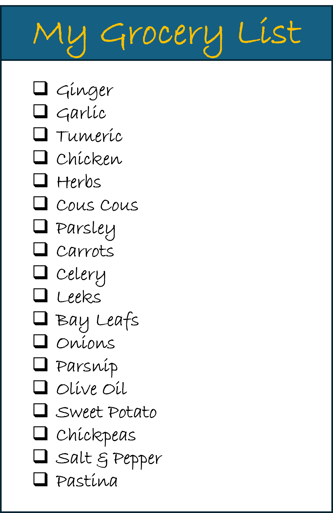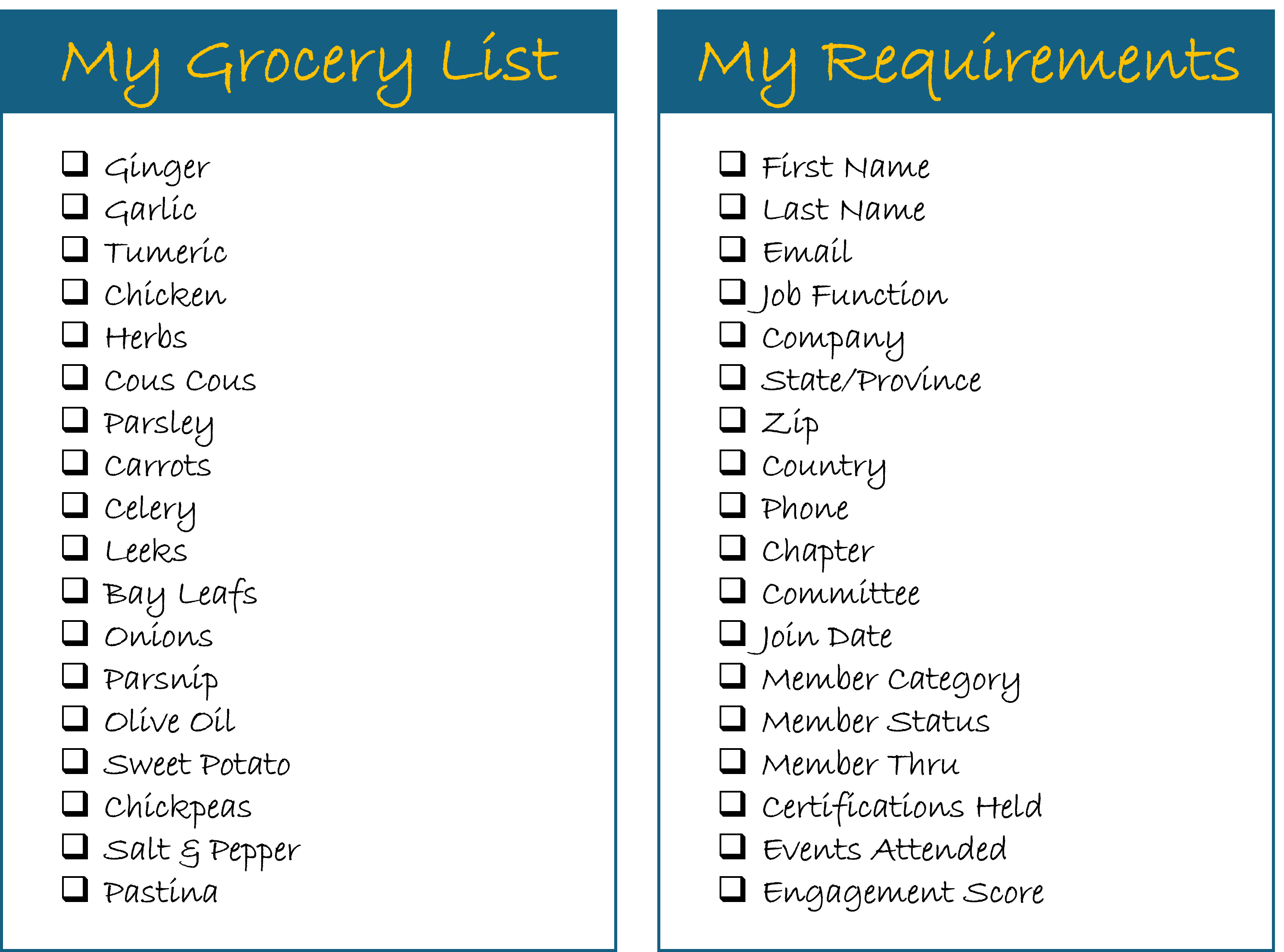When you think business requirements, think chicken soup.
There are a lot of terms thrown around when it comes to identifying the right data to sync from one system to another. Requirements gathering, requirements capturing, requirements elicitation. They’re all different ways of saying that the same thing—"let's identify the data that's going to move our association in the right direction."
In the end, it’s about digging deep on what your organization needs to grow, sustain, or change and following that trail to the end of the data line. Come to think of it, identifying the right data to bring from one system to another isn't unlike making chicken soup. Yes, you heard that right. Let's dig into that.
A palatable framework (pun intended)
Requirements gathering seems arduous and abstract but, in the end, there’s a simple framework that makes the process less overwhelming.
So once again, let's talk soup.
I want to make some homemade chicken soup for a winter party this month. How do I go about the process of identifying what ingredients I need to pick-up from the grocery store in preparation for the party? How do I get to the list of what's needed from the store to my home. Let’s take a look at how I would frame this out:
My objective
To make a variety of homemade chicken soups for a winter dinner party of 10 (including kids). Ultimately, the soup will:- Warm us up
- Bring us comfort
- Give us sustenance
My approach
I have three different recipes that I’m going to draw from, plus a little of my own magic.My recipes (per group)
Gut Happy Chicken Soup → Adults Vegetarian Chicken Soup → Vegetarians/Vegans
Kids Chicken Soup → Children under 12
My ingredients (per recipe)
1—Gut Happy Chicken Soup
Ginger, Garlic, Turmeric, Chicken, Herbs, Cous Cous
Ginger, Garlic, Turmeric, Chicken, Herbs, Cous Cous
2—Vegetarian Chicken Soup
Parsley, Garlic, Carrots, Celery, Leeks, Bay Leafs, Onions, Parsnip, Olive Oil, Sweet Potato, Chickpeas
3—Kids Chicken Soup
Shredded Chicken, Carrots, Celery, Onion, Salt & Pepper, Pastina
Shredded Chicken, Carrots, Celery, Onion, Salt & Pepper, Pastina
My final grocery list

Asking what needs to be asked
So am I oversimplifying? Perhaps. Am I maybe just hungry? Also a possibility. But in the end, finding the right recipes and pulling out those ingredients is a good way of looking at business requirements gathering. It's about looking at the bigger picture, asking the right questions, and drilling down into the details.
Keep in mind, when you're talking about an integration, the intention is to pull data from your source (starting point) to your destination (ending point). Reasons for integration always bubble up to the same sentiment. You want that live feed of data flowing from your management tool (like an Association Management System) into an execution and/or delivery tool (like HubSpot).
Your source, which is typically (but not always), your AMS is generally holding a larger set of data and contacts. AMS' are about data recordation and data management. So volume makes sense.
But when it comes to data activation through sales, marketing, services, and other activities, some of the data sitting in your AMS just isn't applicable to what you're looking to accomplish. Thus, a need for requirements gathering.
'Who' do I want to bring over?
So what are the questions you want to ask yourself? The who is the best place to start. Identifying the who seems relatively easy but there's a little more context to consider. I always recommend categorizing your audiences at the broadest level and determining who you want to bring over:
- Members: individuals or orgs who hold an existing membership with you
- Customers: individuals or orgs who have purchased another program/product from you (i.e. CE attendees, donors, lapsed members)
- Prospects: individuals or orgs who have either no familiarity with you or some familiarity but haven't consumed your content or products in 3+ years (i.e. an attendee from an event that took place 10 years ago)
Who you bring over, and the business rules around that, are entirely up to you. It could be members. It could be members and customers. It could be prospects going back five years. Just note that, whoever you're opening the gate for, there should be a plan in place for that audience now or in the future.
'How [many]' do I want to bring over?
How many is an interesting one. Because the natural reaction is to assume you want everyone and everything. Not the case. Once again, the AMS is a container that holds a great deal of data. Not all of that data is relevant for marketing, sales, or even services. And when it comes to platforms like HubSpot who price by capacity, you want to make sure you're having the conversation at the onset so that you're mapping your HubSpot capacity with your expectations for integration.
Yes, you may not always know exactly who you want to bring over until you start the requirements session. And that's totally fine. There's always room to increase capacity if that's the case. But for the most part, airing on the side of more HubSpot capacity (with ample room to grow) than less is your best bet.
'What' do I want to bring over?
Once you've identified who you're bringing over, and how many of those who's, you want to identify what attributes (fields) are coming along with that contact. This is where you're going to start questioning from the top and trickling down so that you can get to those 'ingredients' I mentioned earlier in the read. Think about these questions:
- What are my organizational, strategic, and/or marketing objectives?
- What audiences fall under each objective?
- What are the campaigns that will fold up under each objective?
- What are the fields and attributes needed to execute on those campaigns?
- What fields are available to me within my AMS?
- Of the fields available to me, are they populated with values?
- What data am I missing in order to execute on my campaigns??
- For data gaps, what’s the roadmap to collect that data?
Now that soup analogy is really coming into play. By answering these questions, you know that to meet your org marks, you need to target A, B, and C audiences, and execute on D, E, and F campaigns. Suddenly, your data ingredients are clear and you have your list of requirements. ↓

Get the right people at the table
The questions are important. They systemically guide your organization through the process. But even more important—getting the right people involved in the conversation so that you're getting the most comprehensive, accurate answers.
This means, not just involving the marketing and tech teams, but any stakeholder within the organization. Anyone accountable for moving the company forward should have a voice. Leadership and program owners may not necessarily be running the campaigns but they're all on the hook for meeting their collective objectives. Representation from all sides of the house is critical.
Committing to the process
Different companies have different processes to collect inputs and guide clients through business requirements collection, and ultimately through integration config. While the framework and even the output may change from company to company, the intention stays relatively the same.
Let's take HighRoad Spark's framework as an example. Now HighRoad is unique because we have years of experience across hundreds of associations and have productized our integration from an output and framework perspective.
Solid frameworks, like Spark's, is needed when it comes to integrating from client AMS' to HubSpot. It's the difference between exhausting and often scattered projects that span months and months versus goal-driven, focused projects that span 12 weeks. Here's a look at the Spark framework:
Step 1: Advisor-led Business Requirements Session
Resources: Once again, all stakeholders
Time: 1 hour
Output: Completed Campaign Ideation Workbook
Step 2: Ongoing marketing and tech consultation around requirements
Resources: Marketing and tech teams
Time: 3-5 hours (clients get one week for internal ideation/discussion)
Step 3: Finalized requirements manifested in a final Tech Spec document
Resources: Marketing and tech teams
Time: 30 minutes (post internal ideation/discussion)
Output: Completed Tech Spec Workbook
Step 4: Technical assets provided by client based on Tech Spec instructions
Resources: Tech team
Time: Variable based on experience and complexity of assets
Output: 100% Asset Delivery Score
Step 5: Once 100% of the tech assets are delivered, configuration begins
Resources: HighRoad team
Output: Spark integration configured
Step 6: Once configured, Q/A internally and externally
Resources: Tech team
Output: 95% Count Match Score
Step 7: Once all tests are passed, final Data Tour so that association knows where and how to access and activate the data they have
Resources: Marketing and tech teams
Time: 1 hour
Output: Live HubSpot data navigation and example list build
Regardless of the framework, starting from broad stroke objectives and drilling down into the finer marketing and segmentation details can seem daunting. In the end, if you're with the right strategic partner and have the right tech stack in place, you're going to end up with a strong, actionable data integration.
Need to connect your AMS data into HubSpot?
Learn how HighRoad Spark + HubSpot can quickly put you in the results zone. Book a consultation today to learn more.
About Aimee Pagano
Aimee joins HighRoad Solution with 15+ years of integrated marketing and communications experience, primarily in client-facing roles within the association and SaaS space. Her specialties include persona development, content strategy/management, lead gen and awareness campaign development, and website development/optimization.






